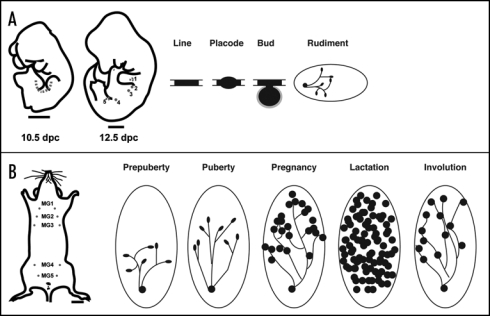Figure 3.
Morphological and schematic development of the mouse mammary gland during embryogenesis and postnatal life. (A) Cartoon illustrating the mammary line at 10.5 dpc in the mouse embryo, and the position of mammary rudiments in the 12.5 dpc mouse embryo. The mammary line forms transiently along the anterior-posterior axis at each flank of the embryo, eventually giving rise to 5 pairs of mammary placodes. There are three thoracic (1–3) and two inguinal (4 and 5) mammary buds. These buds give rise to a rudimental ductal tree by birth. (B) In the adult female mouse five pairs of mammary glands are found: three thoracic gland (1–3) and two inguinal glands (4 and 5). During puberty, hormones induce the rudimentry ductal network to elongate and proliferate. The ends of growing ducts form terminal end buds (TEB) during puberty (solid black ovals). The large oval shown in the postnatal stages depicts the mammary fat pad (stroma). During pregnancy, alveolar proliferation and differentiation occurs to produce milk proteins for mammary function during lactation. Mammary ducts are shown as solid lines and the lobuloalveolar structures are presented as solid black circles. Tissue remodeling and cell death occur during involution and bring the gland back to a virgin-like resting state. Scale bars in (A) embryo 1000 mm; (B) adult, 2500 mm.

